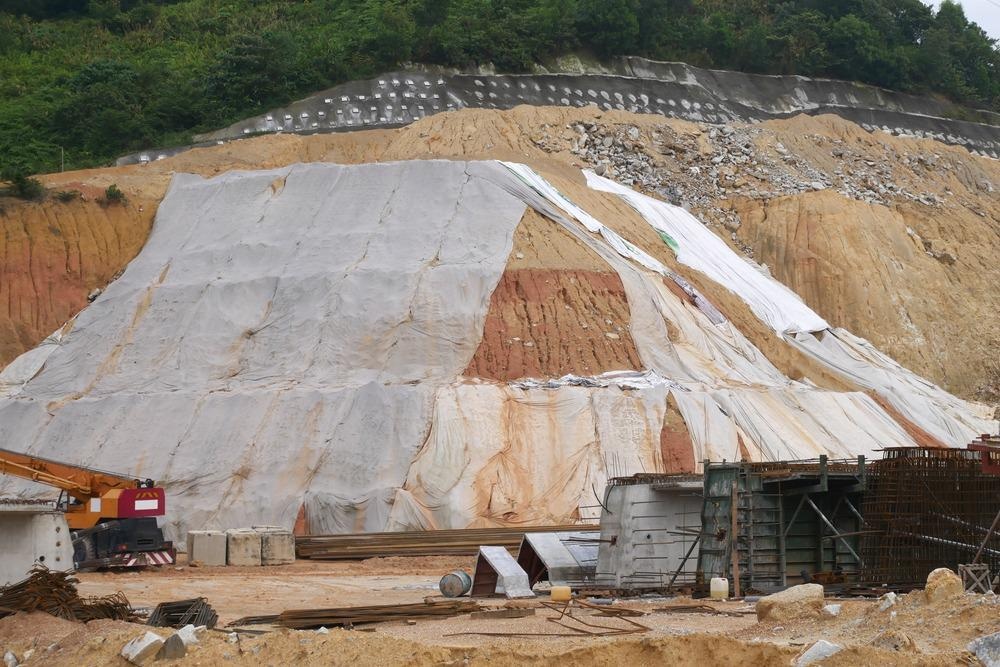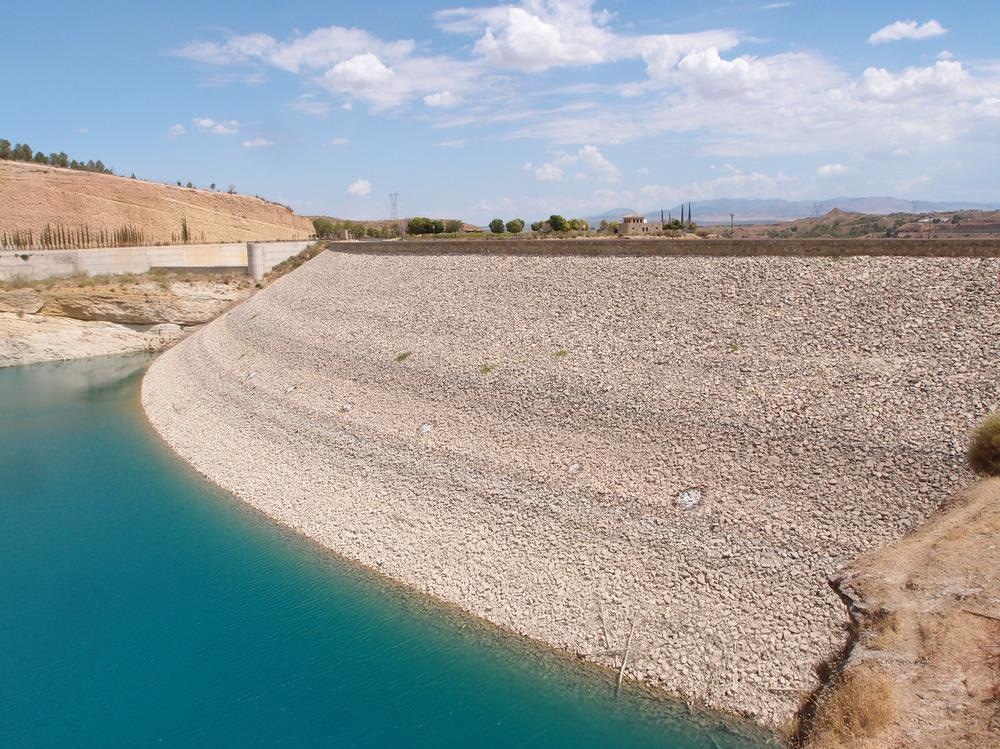Geotextiles are permeable synthetic textiles. They are generally produced from polypropylene polymers or polyester, and are primarily used in dams to increase soil stability while improving erosion control and drainage.

Image Credit: Aisyaqilumaranas/Shutterstock.com
In this paper, the use of geotextiles in embankment dams, the components used in the design and construction of embankment dams, and why the industry has been hesitant to use this application will be discussed.
Due to the unavailability or cost of natural aggregates, geotextiles have been used as substitutes.
The vast majority of geotextiles are used in shallow-burial applications such as separators/filters and underneath erosion control materials. The geotextiles that are placed deep inside an embankment dam are less widespread, and in most agencies are forbidden when used in such situations.
Geotextiles have been used as deeply buried filters in dams in South Africa, Germany, France, and many more countries. Some of the structures associated with geotextiles have been in use for more than a quarter-century. In particular, for almost 35 years, the geotextile placed as a filter for the Valcross dam has been successful.
Why are Geotextiles Used in Dam Construction?
For well over 45 years, geotextiles have been utilized in dam rehabilitation and construction. The construction material is being utilized at an ever-increasing rate and has various design applications, such as surface erosion control, reinforcement, protection, drainage conveyance, and filtration.
More frequently, geotextiles have been used as separator functions for drainage aggregates or riprap and have also been used to improve the slope stability of an embankment.
The materials are not new to the dam rehabilitation and construction industry and are also considered reliable and durable civil engineering material with acceptable performance in buried and exposed applications. Geotextiles are often used because they may be a practicable choice for a specific application, while also providing a durable and viable economic alternative to other types of conventional civil engineering materials.
Common Performance Problems when Utilizing Geotextiles
If the performance of building materials is compromised in any way, the full economic or technical advantages cannot be realized. This is the case for geotextile products, so much so that the United States does not accept the application of geotextiles as an engineering practice. Due to its unreliability, many organizations also forbid the use due to concerns of costly repairs or failure to the dam itself.
The performance problems can be attributed to one of the following mechanisms of failure or risk: excessive clogging or piping, stress-induced distortion, environmental degradation, slope instability, or rupture.
Clogging occurs when particles of foreign material fill the void space, reducing permeability. As this occurs, the geotextile material is unable to adequately perform its intended function of filtration and drainage. On the other hand, piping of soil occurs when the soil in large quantities can pass through the openings freely.
This can cause internal erosion of the embankment and the material can no longer act as a protective filter. Piping often leads to excessive clogging.

Image Credit: josera/Shutterstock.com
The second problem of stress-induced distortion is often caused by the selection of the geotextile in the design phase. If the material had been selected based on an unstressed state the selection is invalid. The fibers react and may become flatter and wider or thinner and longer, and this affects the drainage functions of the material.
Several environmental factors lead to degradation, reducing the service life of the geotextile material. The prolonged exposure of the material in conjunction with the depth of the material is the main reason why it may degrade. For example, deeply buried geotextile materials are protected from the effect of high temperatures and oxidation. However, shallow burial applications do not and are expected to have a shortened life span.
Chemicals within the soil composition can degrade the different specific polymers. As an example, diesel fuel can degrade polypropylene and polyethylene geotextiles.
Another predominant issue as to why geotextiles may cause problems in the construction of the dams is during the installation phase. Undetected damage from installation, plant or animal intrusion, or cracking of the embankment can cause tearing, punctures, abrasion, and contamination of the geotextile material compromising performance.
Encouraging and Expanding the Use within Construction of Dams
A new study by the Federal Emergency Management Agency, in collaboration with other governing bodies, aims to expand the opportunity for geotextiles to be utilized in embankment dams within the United States. They have identified three conditions that have to be met to do so.
The first is that it has to be shown that the material does not have a ‘fatal flaw’ that cannot be addressed through the design, manufacture, or construction control phase/s satisfactorily. Secondly, the reason to select a geotextile material over conventional dam construction material must be compelling in nature, i.e., the advantages of lower cost and rapid construction.
The final requirement is that the revision of strict agency policies has to be done for confidence that the material can be used in dam construction.
Ultimately, the decision to use a geotextile material in the construction design is up to the design engineer and owner, but also to a certain degree the regulatory body. However, the information readily available to these parties is limited and requires specialized knowledge of the design process. Therefore, utilizing geotextile material in the construction of dams is very much a case-by-case judgment and may not be suitable for mainstream use.
Further Recommendations
Overall, there is a valid and viable case for the use of geotextiles in embankment dams for both shallow and deep burial, as there are many design cases where they have been successful. However, the information is not readily available as to how to overcome the problems that occur due to poor installation monitoring, environmental factors, or even general quality control.
The study further recommends that a comprehensive document is required on the design, installation, and monitoring of geotextiles. It should incorporate an assessment of failure modes and responses to potential likely problems with geotextiles. It is suggested the document should also incorporate a database of case history examples to gain further knowledge of service life and performance evaluation.
Further Reading and References
What is a Geotextile? - Definition from Corrosionpedia, 2021, Corrosionpedia. 2021. What is a Geotextile? - Definition from Corrosionpedia. [online] Available at: <https://www.corrosionpedia.com/definition/1947/geoutilizedever-increasinga>
Federal Emergency Management Agency, 2008. Geotextiles in Embankment Dams. [online] Available at:<https://damsafety-prod.s3.amazonaws.com/s3fs-public/files/FEMA%20TM%20GeotextilesInEmbankmentDams2008.pdf
Disclaimer: The views expressed here are those of the author expressed in their private capacity and do not necessarily represent the views of AZoM.com Limited T/A AZoNetwork the owner and operator of this website. This disclaimer forms part of the Terms and conditions of use of this website.